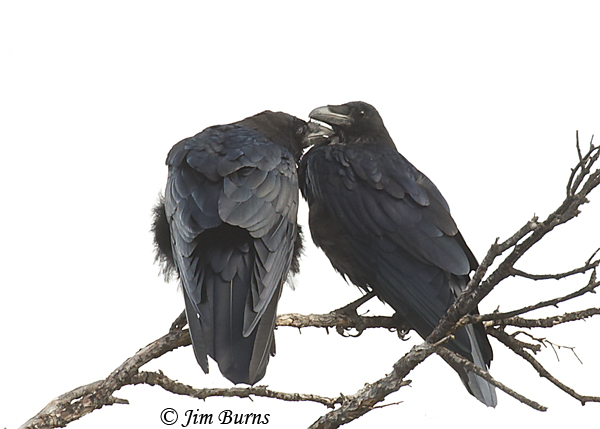
I turn to gape in awe at the 360 view, turn back to the tree and she is there, just below him on the same branch. She has come up out of one of the canyons or perhaps from a protected overnight roost in this wilderness of rocks. Even as I process the fact that this second bird seems slightly but noticeably smaller and is probably the female of this mated pair, she sidles up the branch, moving closer to him.
He is busy preening body feathers and wings, occasionally emitting one of the guttural, inimitable croaks that ravens give. The ones that set birdwatchers on edge, because of its other worldly quality and because they can’t imagine what creature could possibly make such a sound, often delivered from high above or far away, not a raven in sight. Sometimes called the Deep Croak, it is thought to be a location advertisement.
Finished with his morning grooming, he reaches with his beak, that massive beak that can pluck a Prairie Dog from the ground with its owner in full flight, toward his mate, now right beside him. Bowing, she lowers her head, and he begins to allopreeen her scalp and nape. I picture a small boy sitting on his ancient grandmother’s lap as she gently scratches the area between his shoulder blades that he cannot himself reach.
As the minutes pass and the clouds build up the female raven next lifts her head, exposing her hackles and upper breast to her mate and he employs his beak in those areas. Finally breaking away she begins her own preening process, the body parts she can reach, then her own wings and tail. He watches, croaking occasionally.
Finishing up with herself, she slowly stretches each wing, shrug preens, then reaches up to him and begins to work on his throat and under his beak. I watch with interest and somewhat in awe, camera shutter clicking, this picture of domestic contentment juxtaposed against the coming chaos of a mountain monsoon storm. This may be better than a colorful sunrise and, for the ravens, may be an exercise predicated by that coming storm. Lightning stabs a nearby ridge, I feel the first patter of giant raindrops. The ravens take wing, flying down the rising wind as I hurry to the refuge of my vehicle.
Ravens have been writ large into human folklore from the beginnings of man as a sentient species. Often their intelligence and personality have made them totems of wisdom. More often their dark plumage and predatory instincts have conjured mystery, fear, and representation of death. This morning at Massai Point I am privileged to have seen a side of ravens seldom observed and little appreciated.